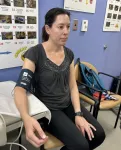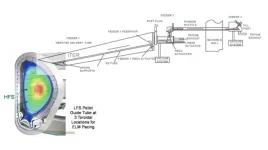(Press-News.org) We’ve seen dramatic increases in life expectancy over the 19th and 20th centuries, thanks to healthier diets, medical advances and many other quality-of-life improvements.
But after nearly doubling over the course of the 20th century, the rate of increase has slowed considerably in the last three decades, according to a new study led by the University of Illinois Chicago.
Despite frequent breakthroughs in medicine and public health, life expectancy at birth in the world’s longest-living populations has increased only an average of six and a half years since 1990, the analysis found. That rate of improvement falls far short of some scientists’ expectations that life expectancy would increase at an accelerated pace in this century and that most people born today will live past 100 years.
The Nature Aging paper, “Implausibility of Radical Life Extension in Humans in the 21st Century,” offers new evidence that humans are approaching a biologically based limit to life. The biggest boosts to longevity have already occurred through successful efforts to combat disease, said lead author S. Jay Olshansky of the UIC School of Public Health. That leaves the damaging effects of aging as the main obstacle to further extension.
“Most people alive today at older ages are living on time that was manufactured by medicine,” said Olshansky, a professor of epidemiology and biostatistics. “But these medical Band-Aids are producing fewer years of life even though they’re occurring at an accelerated pace, implying that the period of rapid increases in life expectancy is now documented to be over.”
That also means extending life expectancy even more by reducing disease could be harmful, if those additional years aren’t healthy years, Olshansky added. “We should now shift our focus to efforts that slow aging and extend healthspan,” he said. Healthspan is a relatively new metric that measures the number of years a person is healthy, not just alive.
The analysis, conducted with researchers from the University of Hawaii, Harvard and UCLA, is the latest chapter in a three-decade debate over the potential limits of human longevity.
In 1990, Olshansky published a paper in Science that argued humans were approaching a ceiling for life expectancy of around 85 years of age and that the most significant gains had already been made. Others predicted that advances in medicine and public health would accelerate 20th-century trends upward into the 21st century.
Thirty-four years later, the evidence reported in the 2024 Nature Aging study supports the idea that life expectancy gains will continue to slow as more people become exposed to the detrimental and immutable effects of aging. The study looked at data from the eight longest-living countries and Hong Kong, as well as the United States — one of only a handful of countries that has seen a decrease in life expectancy in the period studied.
“Our result overturns the conventional wisdom that the natural longevity endowment for our species is somewhere on the horizon ahead of us — a life expectancy beyond where we are today,” Olshansky said. “Instead, it’s behind us — somewhere in the 30- to 60-year range. We’ve now proven that modern medicine is yielding incrementally smaller improvements in longevity even though medical advances are occurring at breakneck speed.”
While more people may reach 100 years and beyond in this century, those cases will remain outliers that won’t move average life expectancy significantly higher, Olshansky said.
That conclusion pushes back against products and industries, such as insurance and wealth-management businesses, which increasingly make calculations based on assumptions that most people will live to be 100.
“This is profoundly bad advice because only a small percentage of the population will live that long in this century,” Olshansky said.
But the finding doesn’t rule out that medicine and science can produce further benefits, he said. There may be more immediate potential in improving quality of life at older ages instead of extending life, the authors argue. More investment should be made in geroscience — the biology of aging, which may hold the seeds of the next wave of health and life extension.
“This is a glass ceiling, not a brick wall,” Olshansky said. “There’s plenty of room for improvement: for reducing risk factors, working to eliminate disparities and encouraging people to adopt healthier lifestyles – all of which can enable people to live longer and healthier. We can push through this glass health and longevity ceiling with geroscience and efforts to slow the effects of aging.”
END
Despite medical advances, life expectancy gains are slowing
2024-10-07
ELSE PRESS RELEASES FROM THIS DATE:
Johns Hopkins Medicine study finds commonly used arm positions can substantially overestimate blood pressure readings
2024-10-07
A study led by Johns Hopkins Medicine researchers concludes that commonly used ways of positioning the patient’s arm during blood pressure (BP) screenings can substantially overestimate test results and may lead to a misdiagnosis of hypertension.
In a report on the study, which will be published Oct. 7 in JAMA Internal Medicine, investigators examined the effects of three different arm positions: an arm supported on a desk, arm supported on a lap, and an unsupported arm hanging at the patient’s side. ...
Arm position and blood pressure readings
2024-10-07
About The Study: This crossover randomized clinical trial showed that commonly used arm positions (lap or side) resulted in substantial overestimation of blood pressure readings and may lead to misdiagnosis and overestimation of hypertension.
Corresponding Author: To contact the corresponding author, Tammy M. Brady, MD, PhD, email tbrady8@jh.edu
To access the embargoed study: Visit our For The Media website at this link https://media.jamanetwork.com/
(doi:10.1001/jamainternmed.2024.5213)
Editor’s Note: Please see the article for additional information, including other authors, author contributions and affiliations, conflict of ...
Longitudinal changes in epigenetic age acceleration across childhood and adolescence
2024-10-07
About The Study: The transition from childhood to adolescence may represent a sensitive developmental period when racism can have long-term deleterious impacts on healthy human development across the life span. Future research should build on the present study and interrogate which social regularities and policies may be perpetuating discrimination against ethnically and racially minoritized adolescents.
Corresponding Author: To contact the corresponding author, Juan Del Toro, PhD, email jdeltoro@umn.edu.
To ...
An early blood test can predict survival in patients with metastatic prostate cancer, shows USC study
2024-10-07
A blood test, performed when metastatic prostate cancer is first diagnosed, can predict which patients are likely to respond to treatment and survive the longest. It can help providers decide which patients should receive standard treatment versus who might stand to benefit from riskier, more aggressive new drug trials. The research, part of a phase 3 clinical trial funded in part by the National Cancer Institute (NCI) of the National Institutes of Health, was just published in JAMA Network Open.
Before it spreads, prostate cancer can be cured with surgery or ...
Scientists discover that special immune cells stop metastatic cancer
2024-10-07
October 7, 2024—(BRONX, NY)—Metastatic disease—when cancer spreads from the primary tumor to other parts of the body—is the cause of most cancer deaths. While researchers understand how cancer cells escape the primary site to seed new tumors, it’s not well understood why some of these wayward cancer cells spawn new tumors— sometimes decades later—while others do not.
Now, a research team at the National Cancer Institute-designated Montefiore Einstein ...
Cancer biologists discover a new mechanism for an old drug
2024-10-07
Since the 1950s, a chemotherapy drug known as 5-fluorouracil has been used to treat many types of cancer, including blood cancers and cancers of the digestive tract.
Doctors have long believed that this drug works by damaging the building blocks of DNA. However, a new study from MIT has found that in cancers of the colon and other gastrointestinal cancers, it actually kills cells by interfering with RNA synthesis.
The findings could have a significant effect on how doctors treat many cancer patients. Usually, 5-fluorouracil is given in combination with chemotherapy drugs that damage ...
Food deserts, limited access to transportation linked to more complications among preschool children with SCD
2024-10-07
(WASHINGTON – October 7, 2024) - A new study finds that preschool-aged children with sickle cell disease (SCD) who live in food deserts and have limited access to transportation are at greater risk for acute complications and hospitalizations, despite receiving free evidence-based therapy and social support, according to results published today in Blood Advances.
“Despite the level of care received by the families and patients within our clinic, we still have a gap in terms of being able to address the barriers ...
Space oddity: Most distant rotating disc galaxy found
2024-10-07
Researchers have discovered the most distant Milky-Way-like galaxy yet observed. Dubbed REBELS-25, this disc galaxy seems as orderly as present-day galaxies, but we see it as it was when the Universe was only 700 million years old. This is surprising since, according to our current understanding of galaxy formation, such early galaxies are expected to appear more chaotic. The rotation and structure of REBELS-25 were revealed using the Atacama Large Millimeter/submillimeter Array (ALMA), in which the European ...
How a common economic theory could help save endangered frogs
2024-10-07
A common theory that guides financial investment strategies may be a handy tool to protect an endangered Puerto Rican frog. A new study uses modern portfolio theory to identify future “investments” in natural resource management that may help managers decide which actions to take to protect coquí llanero populations in Puerto Rico.
The 17 species of coquí frogs, and their signature high-pitched chirp, are considered unofficial mascots of Puerto Rico. The entire population of coquí llanero frogs, the smallest and possibly most endangered of the island’s coquís, ...
Stopping off-the-wall behavior in fusion reactors
2024-10-07
Fusion researchers are increasingly turning to the element tungsten when looking for an ideal material for components that will directly face the plasma inside fusion reactors known as tokamaks and stellarators. But under the intense heat of fusion plasma, tungsten atoms from the wall can sputter off and enter the plasma. Too much tungsten in the plasma would substantially cool it, which would make sustaining fusion reactions very challenging. Now, researchers at the U.S. Department of Energy’s Princeton Plasma Physics Laboratory (PPPL) have experimental results suggesting that sprinkling ...





